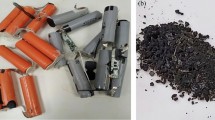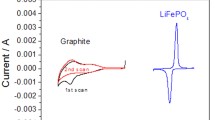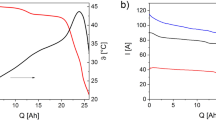Abstract
We have investigated an inorganic lithium battery system in which LiCoO2 is used as the positive electrode and lithium, intercalated into graphite, serves as negative electrode. The conducting salt is lithium tetrachloroaluminate (LiAlCl4). The electrolyte is based on SO2. It has been shown that a layer of lithium hydroxide is present on the surface of the lithium cobalt oxide. This has a negative impact on the stability of the electrode. To improve stability, we have developed a purification process for removing the lithium hydroxide from the surface of the positive electrode. After purification the cells show no significant change in either capacity or internal resistance when cycled. Up to 70% of the theoretical capacity of electrodes which have been purified in this way can be used without any negative effects being observed. To prevent the deposition of metallic lithium leading to a hazardous situation, a new safety concept was developed whereby local short circuits are allowable. Safe functioning of the new concept has been demonstrated with tests on complete cells.
Similar content being viewed by others
References
Abraham K.M. (1993). Electrochim. Acta 38(9):1233
Maleki H., Deng G., Anani A., Howard J. (1999). Yogi. J. Electrochem. Soc. 146(9):3224–3229
Hatchard T.D., MacNeil D.D., Basu A., Dahn J.R. (1999). Yogi. J. Electrochem. Soc. 148(7):A755–A761
M. Wakihara and O. Yamamoto (Ed.), ‘Lithium Ion Batteries’ (Wiley-VCH, 1998)
C. Ripp, V. Döge, K. Pinkwart and G. Hambitzer, GDCh-Monographien (1997) 12
US-Patent 09/926,768
Stassen I., Hambitzer G. (2002). J. Power Sources 105:145
G. Hambitzer, Post-doctoral thesis, Universität Witten-Herdecke, 1995
C. Ripp, V. Döge, K. Pinkwart and G. Hambitzer, GDCh-Monographien (1999) 18
Kanamura K., Tamura H., Shiraishi S., Takehara Z.-I. (1995). Yogi. J. Electroanal. Chem. 394:49
International Patent Application PCT/DE 2004/002105
Wang H., Jang Y-I., Huang B., Sadoway D.R., Chiang Y-M. (1999). Yogi. J. Electrochem. Soc. 146:473
Acknowledgments
We thank “Zentrum für Sonnenenergie und Wasserstoff-Forschung (ZSW), Ulm, Baden-Württemberg, Germany”, who carried out some of the measurements.
Author information
Authors and Affiliations
Corresponding author
Rights and permissions
About this article
Cite this article
Zinck, L., Borck, M., Ripp, C. et al. Purification process for an inorganic rechargeable lithium battery and new safety concepts. J Appl Electrochem 36, 1291–1295 (2006). https://doi.org/10.1007/s10800-006-9184-1
Received:
Accepted:
Published:
Issue Date:
DOI: https://doi.org/10.1007/s10800-006-9184-1




